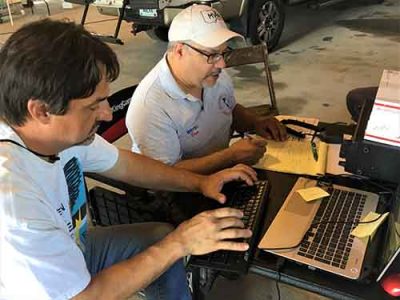Ham radio users reach across world

Dean DeMain, right, a 31-year Mahoning Valley Amateur Radio Association member, records communications he made during the MVARA’s Field Day on Sunday at the Mill Creek MetroParks Farm in Canfield, as Joe Vasko, a 25-year club member, assists. DeMain spoke with another amateur radio operator in Toronto, he said. Association members used a network of computers, power supplies, hand-held microphones, sophisticated radios and antennas to communicate with other operators near and far. Correspondent photo / Sean Barron
CANFIELD — It’s easy to assume that amateur radio operators who communicate with one another are merely engaging in an enjoyable pastime or avocation, but Frank Sole won’t hesitate to spread that notion farther and wider.
“Amateur radio most people view as a hobby, but if you look at the FCC rules and regulations, it’s a service, not a hobby,” Sole, a Mahoning Valley Amateur Radio Association member, observed. “We were actually the birth of radio in this country and world, really.”
Sole was among the radio operators who conducted continuous emergency communications and other demonstrations for 24 hours Saturday and Sunday during Field Day activities at the Mill Creek MetroParks Farm, 7574 Columbiana Canfield Road.
The MVARA took a hiatus last year because of the pandemic.
Several club members spent much of Sunday morning communicating via laptop computers, sophisticated 100-watt Icom radios, hand-held microphones and power-supply boxes with other amateur radio operators near and far. Outside the barn in which they set up the equipment was a loose network of simple antennas that got their signals out.
Calling amateur radio operators, “the minutemen of communications,” Sole noted that many of them also are storm spotters who communicate with the National Weather Service regarding severe weather threats. Their observations are crucial largely because they can see tornadoes and severe storms in real time before Doppler radar can detect such activity, explained Sole, a former broadcaster for WFMJ-TV 21.
For example, amateur radio operators tracked the May 31, 1985, tornado outbreak that destroyed portions of Niles, Newton Falls, Hubbard and several towns in western Pennsylvania. Specifically, they provided communications in locations that lacked phone service for several days, as well as in shelters after the storms, Sole remembered.
Greatly aiding the MVARA is a repeater device that is about 350 feet high and able to amplify and repeat signals it receives, which gives it the ability to cover all of Mahoning County and beyond, Sole continued.
In addition, club members can use Winlink, a global wireless radio email network that uses radio pathways in places the internet is unavailable, such as after a natural disaster.
“For a disaster, there’s nothing better,” Sole said, noting that its role, as well as that of amateur radio personnel, was vital in the aftermath of Hurricane Michael that struck the Florida panhandle in October 2018 and left much of the region without communications for about two weeks.
Amateur radio operators also are behind the scenes at large nonemergency activities such as parades and fairs, as well as major local events, including the annual Panerathon and Peace Race. They are ready to assist if a runner suffers a sprained ankle or other injury and needs an emergency medical technician, for example, Sole explained.
In addition, the MVARA has a relationship with the Mahoning County Emergency Management Agency and the American Red Cross. Many of the more than 700,000 ham radio operators in the U.S. also share their skills and knowledge with Boy and Girl Scouts, he added.
Among those happy to discuss their communications acumen Sunday was Scott Wilton of Kinsman, MVARA president, who carefully kept a log of operators with whom he communicated, including a Field Day participant in northern New York. One piece of equipment that aided in his effort was an elaborate power-supply box on top of which sat a small antenna.
“It’ll do anything I want it to do,” Wilton said of the device, which he called a “shack in the box” because of its capability to handle numerous frequencies and bandwidths. “It saves me from buying four or five radios when I can have one.”
Also speaking far and wide were 31-year MVARA member Dean DeMain and Joe Vasko, who’s been with the club about 25 years. DeMain tried unsuccessfully to speak to a woman operator in Maine, but was able to connect to someone in Toronto, he said.
Despite amateur radio operators’ key roles in disaster preparedness and other serious endeavors, room still can be found for them to derive fun and enjoyment from their skills and complicated knowledge.
“There’s something magic about sitting down at a box and talking to someone around the world,” Sole said.
news@vindy.com


